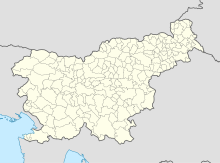
Graz is the capital of the Austrian federal state of Styria and the second-largest city in Austria, after Vienna. As of 1 January 2024, Graz had a population of 303,270. In 2023, the population of the Graz larger urban zone (LUZ) stood at 660,238. Graz is known as a college and university city, with four colleges and four universities. Combined, the city is home to more than 60,000 students. Its historic centre (Altstadt) is one of the best-preserved city centres in Central Europe.

The Duchy of Krumlov was a titular duchy in the southern part of the Kingdom of Bohemia, comprising the town of Český Krumlov and its surrounding territories, now in the Czech Republic.
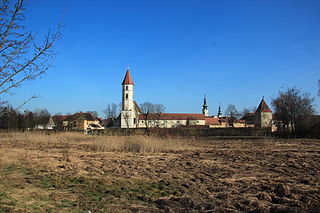
Bad Radkersburg is a spa town in the southeast of the Austrian state of Styria, in the district of Südoststeiermark.

Vimperk is a town in Prachatice District in the South Bohemian Region of the Czech Republic. It has about 7,400 inhabitants. The historic town centre is well preserved and is protected by law as an urban monument zone.

Prince Hans Ulrich von Eggenberg was an Austrian statesman, a son of Seyfried von Eggenberg, Lord of Erbersdorf (1526–1594), and great-grandson of Balthasar Eggenberger. He was a prominent member of the House of Eggenberg and gained the title of Duke of Krumau.

Gornja Radgona is a town in Slovenia. It is the seat of the Municipality of Gornja Radgona. Once it was a defensive stronghold for today's regional centre and its twin city, Bad Radkersburg, on the other side of the Mura River in Austria. The towns were split in 1919, when the state of Styria was divided between Austria and Slovenia. They afterward developed separately, and Gornja Radgona grew into a new town centre.
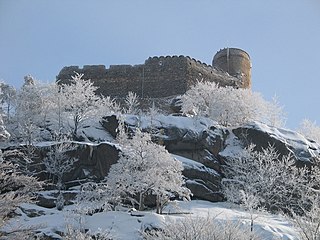
Chojnik Castle is a castle located above the town of Sobieszów, today part of Jelenia Góra in southwestern Poland. Its remains stand on top of the Chojnik hill within the Karkonosze National Park, overlooking the Jelenia Góra valley.

Predjama Castle is a Renaissance castle built within a cave mouth in south-central Slovenia, in the historical region of Inner Carniola. It is located in the village of Predjama, approximately 11 kilometres from the town of Postojna and 9 kilometres from Postojna Cave.

Brežice Castle is a 16th-century castle in the town of Brežice, in southeastern Slovenia, at the street address Cesta prvih borcev 1.

Sevnica Castle is a Slovenian castle in the Lower Sava Valley. Situated atop a hill, it dominates the old town of Sevnica and offers views of the surrounding countryside.
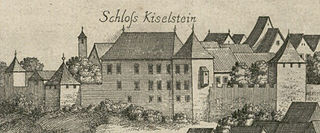
Kieselstein Castle, also known as Khislstein, is a 13th-century castle in the city of Kranj, in the Upper Carniola region of Slovenia.

Snežnik Castle is a 13th-century castle located in the southwest part of the Lož Valley near the settlement of Kozarišče in the municipality of Loška Dolina, Slovenia. Its name is coincidentally identical to a univerbation based on the Slovene word sneg 'snow', but is actually a Slovenized form of the name of the noble house of Schneberg, whose possession it initially was. The Schnebergs were followed by the houses of Lamberg, Eggenberg, Lichtenberg, and Schönburg-Waldenburg.

Eggenberg Palace in Graz, is the most significant Baroque palace complex in the Austrian state of Styria. With its preserved accouterments, the extensive scenic gardens, as well as some special collections from the Universalmuseum Joanneum housed in the palace and surrounding park, Schloss Eggenberg ranks among the most valuable cultural treasures of Austria. Eggenberg Palace is situated at an elevation of 381 meters on the Western edge of the city. Its architectural design and the still visible imprint of centuries of history continue to bear witness to the vicissitude and patronage of the one-time mightiest dynasty in Styria, the House of Eggenberg.

Český Krumlov is a town in the South Bohemian Region of the Czech Republic. It has about 13,000 inhabitants. It is known as a tourist centre, which is among the most visited places in the country. The historic centre with the Český Krumlov Castle complex is protected by law as an urban monument reservation, and since 1992, it has been a designated UNESCO World Heritage Site because of its well-preserved Gothic, Renaissance and Baroque architecture.
Balthasar Eggenberger, was an Austrian entrepreneur in the early days of mercantilism. He was master of the imperial mint at Graz in the Duchy of Styria and financier to Frederick III, Holy Roman Emperor. He was a man cut of the same cloth as the likes of the Burgundian chancellor Nicolas Rolin, French merchant Jacques Coeur and the Medici of Italy, whose cunning, ambition and skills allowed them to advance into the ranks of the nobility from mere common ancestry in the late Middle Ages and early modern era. His activities laid an important foundation stone for the ascension of the House of Eggenberg.
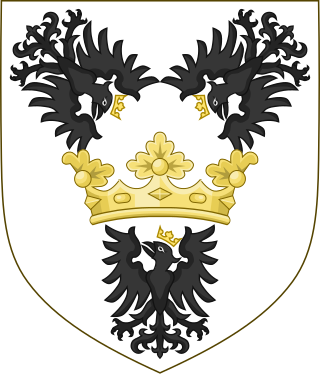
The House of Eggenberg was the name of an influential Austrian noble family from Styria, who achieved princely rank in the 17th century. The family's last male heir died in 1717, bringing an end to the House of Eggenberg.
Mele is a village immediately southeast of Gornja Radgona in northeastern Slovenia.

Český Krumlov Castle is a castle in Český Krumlov in the South Bohemian Region of the Czech Republic. It dates back to 1253 when the first castle was built by the Vítkovci family, the main branch of the powerful Bohemian family Rosenberg.

Grad is a village in the Municipality of Grad in the Prekmurje region of northeastern Slovenia. It is the seat of the municipality and is the largest and oldest settlement in the Goričko region.

Športno nogometni klub Radgona or simply ŠNK Radgona is a Slovenian football club from the town of Gornja Radgona. The club was established in 1946 as FD Gornja Radgona and plays its home matches at the Gornja Radgona Stadium, located in the Gornja Radgona Sports Park, with a seating capacity for 301 spectators.

